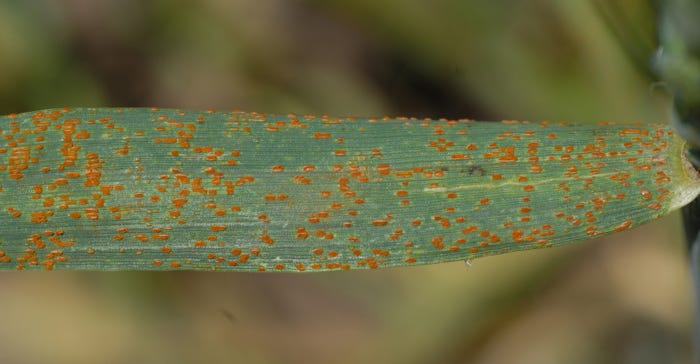
The Great Plains are far from the Rust Belt, but not when you speak in context of wheat diseases.
Stephen Wegulo alerts wheat growers to keep an eye out for the three main rust diseases that affect Nebraska wheat fields — stem rust, leaf rust and stripe rust. For these rusts or any crop disease to occur, three things need to exist, in what Wegulo calls the “Disease Triangle.”
“You need to have a favorable environment, a suitable host and a pathogen that is capable of causing disease,” says Wegulo, a Nebraska Extension plant pathologist who presented at the UNL Crop Production Clinics earlier this winter. “If we take away any of these factors, we will not have disease.”
Not created equal
These three rusts share similarities, yet vary. Each of them is favored by wet weather, but they appear in the state at different times and are favored by differing temperature ranges. Stem rust first appears in Nebraska in June because it is favored by warm temperatures, with the optimum range for its development between 79 and 86 degrees F.
Leaf rust is favored by moderate-to-warm temperatures between 68 and 77 degrees, and therefore it shows up in late May to early June. The early riser in this rust trio is stripe rust, which appears in Nebraska in April to early May because cool temperatures favor its development, with an optimum range of 50 to 59 degrees.

LEAF RUST: Leaf rust is seen here.
Of these three rusts, Wegulo says leaf and stripe rust are more common than stem rust in Nebraska, but the spores of each of the rusts start their journey in the South, riding winds on the Puccinia Pathway from the southern U.S. and Mexico.
Primary infections, promoted by wet weather, will start once spores reach wheat fields, with future spore generations every seven to 10 days after the initial infection. Wind continues to spread the spores within a field, Wegulo says, causing secondary infections. Severe yield loss may occur if spread continues to four or more generations.
Stem rust, or black rust, occurs on stems, leaves and heads of wheat. Elongated orange-to-dark-red pustules form randomly on both surfaces of leaves. Wegulo says the rust can destroy entire wheat fields over a large area in only a few weeks.

STEM RUST: Stem rust infects a wheat head.
Stem rust is the least common of the three. The reason for stem rust’s decline in the state, after major epidemics in the U.S. from 1916 to the early 1950s caused billions of dollars in losses, is twofold.
“Wheat breeders have done a good job” in creating resistant wheat varieties grown in Nebraska, Wegulo says. Stem rust also survives on an alternate host, and it was found that the common barberry plays that role, but that plant was eradicated from the landscape in the 20th century.
Leaf rust, also known as brown rust or orange rust, occurs on the upper surfaces of leaves. Orange-brown pustules form randomly on the leaves, and are round or slightly elongated. Wegulo says leaf rust occurs every year to varying degrees in Nebraska, and yield losses can be more than 50%.
While stripe rust most commonly occurs on the upper surfaces of the leaves, it can also appear on wheat heads when infection is severe. As the name implies, yellow-to-orange pustules form distinct stripes on mature leaves. Typical stripes do not form on leaves of young wheat plants. Also known as yellow rust, yield losses can be more than 50%.
Wegulo shares results from 2021 UNL trials showing fungicides were effective in decreasing the severity of stripe and leaf rust, even when they were applied later than the optimum timing, which is at 50% to 100% flag leaf emergence.
While the untreated crop had 84% severity, wheat treated with different products and timing of applications — flowering or heading �— showed fungicides lessened severity to between 28% and 42%.
Managing rust
“We do have some wheat varieties that have very good resistance,” Wegulo says. “However, be aware that resistance can break down as new races of rusts emerge.”
He also suggests that farmers keep an eye on the sky, monitoring weather closely. “If it’s wet, that’s favorable for rust, so watch out and get ready,” Wegulo says.
It’s also important to monitor what’s happening in Southern states. If there are rust reports in Oklahoma and Kansas, those spores could be on their way here.
Scouting fields should start in April, and Wegulo suggests applying a fungicide for stripe rust and leaf rust timed to protect the flag leaf if your variety is susceptible.
“Fortunately, we don’t see a lot of stem rust, but if you do and if you have a susceptible variety, you need to apply the fungicide immediately, especially if wet weather is prevailing,” he says. “Because if stem rust takes off, it can destroy the crop pretty quickly.”
Learn more by contacting Wegulo at [email protected].
About the Author(s)
You May Also Like






